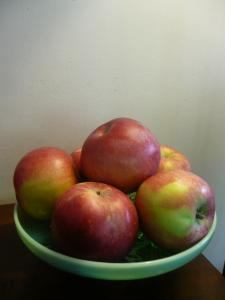
September means back to school. The last of the tomatoes, and the first pumpkins. Cooler nights. The angle of the autumn light. And for many families celebrating Judaism, a scramble to figure out how to celebrate the High Holy Days.
The New Year of 5778 in the Hebrew calendar starts at sundown on September 20th this year. That means that the High Holy Days start with Rosh Hashanah on the evening of September 20th. And the Days of Awe always conclude ten days later with Yom Kippur, which starts this year with the Kol Nidre service on the evening of September 29th.
Fall sends many interfaith families in search of a spiritual home. For those who want to give children a (not necessarily exclusive) Jewish education and identity, at least two different options now exist in many places. Jewish communities have become more inclusive and welcoming to interfaith families. And at the same time, a growing proportion of interfaith families are seeking out communities to support them in celebrating both family religions.
Jewish religious educators and clergy have created programs to serve interfaith families, and have become more skilled in creating warm and appreciative pathways for interfaith families choosing membership in Jewish communities, whether or not the Christian (or Muslim, or Hindu, or Buddhist) spouse converts to Judaism.
What you will not find in these Jewish interfaith family programs is the support and advice of Christian clergy ( with one notable exception, that I'm aware of, in NYC), or education for children about Christianity. And partly in response to these limitations, intentional, independent interfaith communities began to grow in many cities across the country in the 1980s, built by families with a desire to provide literacy in both religions for children, and spiritual support for both spouses.
The High Holy Day services these interfaith communities provide, or the Jewish services they attend as a group, are not a mixture of the two religions. They are traditional services, chosen or designed to be as welcoming and inclusive as possible, and celebrated by interfaith families together as a group sharing profound respect for both religions.
In New York, intermarried couples first designed their own High Holy Day services led by interfaith families in Manhattan in the 1980s. Today, families from the Interfaith Community chapters throughout the New York metropolitan area, including New Jersey and Long Island, gather to celebrate together, both at their own events, and with local Jewish communities.
In Chicago, Jewish and Catholic families have been teaching children both religions since 1993. Chicagoland families from the Interfaith Family School downtown, and the suburban interfaith families from the Interfaith Union, attend services together at local synagogues for the High Holy Days.
And in Washington DC, my own community, the Interfaith Families Project (IFFP), provides a full set of four traditional (yet progressive) High Holy Day services specifically designed by and for interfaith families, now led by Rabbi Rain Zohav. IFFP also provides specific children's services on both holidays.
Meanwhile, families from IFFP in DC who moved to Philadelphia started their own interfaith families community, to teach both religions, years ago now. You can join them for their 9th annual Rosh Hashanah apple-picking event this year. Growing up, my Reform Jewish family always went apple-picking around Rosh Hashanah: it's a lovely tradition!
But what if you live in Seattle, or Nashville, or anyplace that does not yet have an intentional interfaith families community? Start by reading my tips on how to get started with Rosh Hashanah at home, and with finding and creating a community of your own. Then, join the Network of Interfaith Family Groups, designed to support families celebrating any two (or more) family religions, and to help you to find other such families in your area. Already, we have a group that is coalescing in Atlanta
Each fall provides a new chance to connect with other interfaith families, to begin religious education for your children, to discover or rediscover the beauty of the Jewish holidays. As the days grow shorter, return, renew, rejoice in the many options for interfaith families.
Journalist Susan Katz Miller is a speaker and consultant on interfaith families, interfaith education, and interfaith peacemaking. Her book Being Both: Embracing Two Religions in One Interfaith Family is available from Beacon Press.
